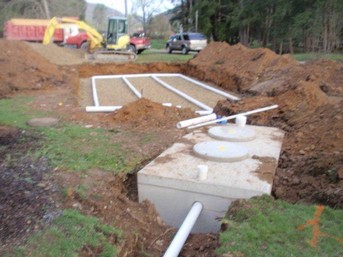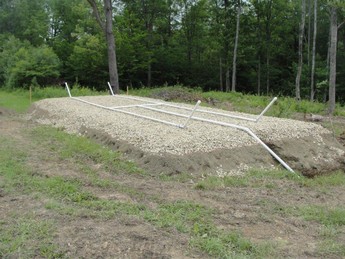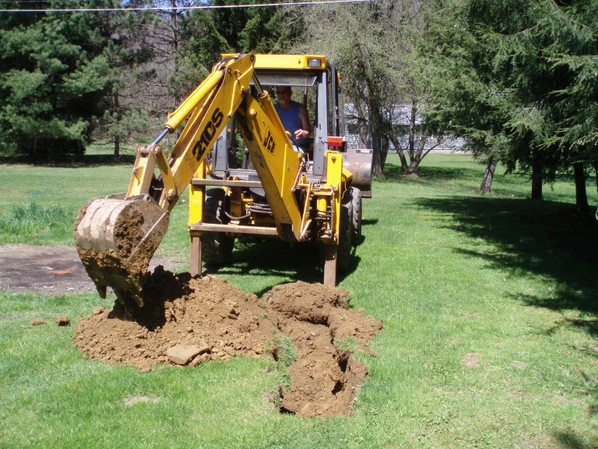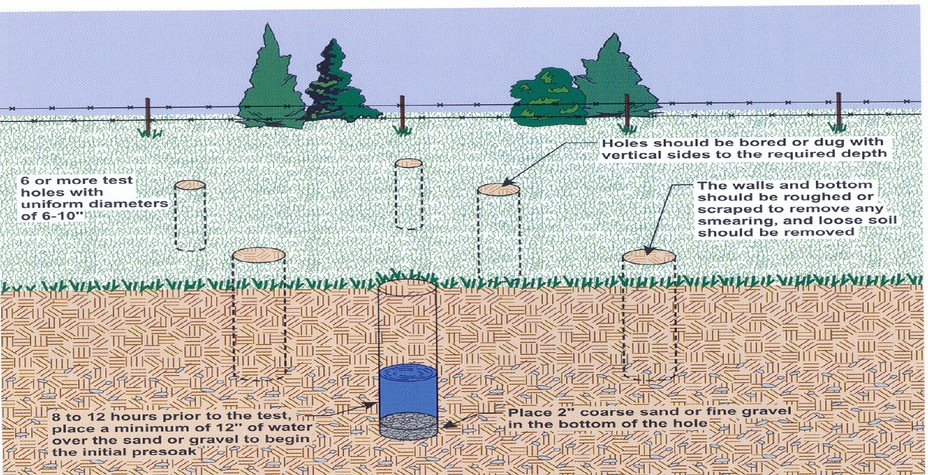Many Pennsylvanians, particularly those living in rural areas, depend on septic systems (also called on-lot systems) to treat the sewage from their home. Properly functioning on-lot systems treat, distribute and dispose of sewage through a clean, economic and efficient process.

The Pennsylvania Sewage Facilities Act (Act 537 of 1966, as amended) requires local agencies to administer a permitting program for the installation of on-lot sewage disposal systems. The purpose of this permitting program is to establish uniform standards to prevent outbreaks of public health and environmental problems from substandard or malfunctioning on-lot systems.
Working With Your Local SEO
The Township administers the on-lot permit program. The certified Sewage Enforcement Officer (SEO) is the Township’s employee responsible for reviewing and approving permit applications and being knowledgeable about on-lot systems. The SEO is trained by DEP and certified by the State Board for Certification of Sewage Enforcement Officers. The SEO is an employee of the local agency, not DEP.



Getting Your Permit
To obtain a permit for an on-lot sewage system the following generalized steps must be followed:
1.The lot owner, or an agent for the owner, applies for a permit through the SEO. If the lot is in a subdivision, the lot owner should first ensure that all other state, county and local planning, zoning and land use requirements have been met by checking with municipal officials.
2.The SEO determines lot slope and conducts soil profile examinations and percolation tests to determine if the site is suitable for an on-lot system. If suitable, the SEO determines which type of on-lot system will work best. If the slope of the site is too steep, on-lot systems cannot be used. The on-lot system also must be isolated away from certain natural and man-made features.
Site & Soil Testing Procedures
Obtaining a Septic System Permit
Anyone who intends to install a septic system must use the following generalized process:
Site Investigation & Deep Soil Probe Test
The first test on the site is a site evaluation and a deep soil probe test. As part of this site and soils investigation, the SEO will also determine if the proposed location of the system will meet certain isolation distance requirements. The sewage system is required to be specific distances (isolated) from natural and man-made features. This is done to assure long term operation of the new system and to prevent ground or surface water pollution. To attain a suitable location, the SEO may need to locate the system on a specific part of the lot.
These isolation distances are:
- Property lines, easements, or right-of-ways: 10 feet
- Occupied buildings, swimming pools, and driveways: 10 feet
- Water wells or springs: 100 feet
- Cisterns used as a water supply: 25 feet
- Water lines under pressure: 10 feet
- Streams, lakes, ponds, or other surface water: 50 feet
- Other septic systems: 5 feet
- Surface Drainageways, stormwater basins, and road ditchs: 10 feet
- Natural or manmade slopes greater than 25%: 10 feet

When conducting a soils profile test, a backhoe is used to dig a pit as deep as eight (8) feet, however depths of three to four feet are more typical. The SEO enters this pit to examine the make up of the soil (soil profile). From examining the color, texture and other physical properties of the soil the SEO will determine the suitability of the soil to place a septic system. If the soil is determined suitable for the installation of a system then a percolation test will be performed. If the soil is determined to be unsuitable, the Application will be denied and no permit will be issued.
To prepare a soil profile examination, the permit Applicant is responsible to have a suitable sized backhoe or excavator on site to dig the test pit(s). The size of the pit will be a maximum of 8 feet deep, and wide enough and tapered on one end so the SEO can get in and out. It is best to schedule the backhoe so that all interested parties and the SEO can be at the site at the same time.
This soils test will determine the type of septic system, if any, that can be permitted on the lot. In Pennsylvania, state regulations require a minimum of 20 inches of suitable soils material from the natural soil surface to the “limiting zone” in order to qualify as acceptable for an on-lot septic system. A “limiting zone” is any condition within the soil geology that limits or alters the downward movement of water and wastewater through the soil.
Locally, the most common soil condition that causes the denial of a permit is the formation of clay hardpans close to the surface that limit or restricts the downward movement of water. Soil particles “hold on” to harmful microbes in the sewage allowing beneficial bacteria in well drained soil to breakdown the sewage effluent before its enters this “limiting zone”. A saturated or wet soil does not allow these naturally occurring soil bacteria to renovate or clean-up sewage wastewater. When the site investigation and soil evaluations are found to be acceptable, a percolation test may only then be conducted. (Note: In some cases a minimum of 10-inches of suitable soils may be acceptable for some new alternate systems.)
Knowing the Types of On-Lot Systems
Determined by the above soils testing, there are three basic conventional on-lot systems permitted for use on residential lots. They are:
Depth of Suitable Soils Maximum Slope Type Of System
Less than 10” N/A Unsuitable
10” to 20 12% Alternate Systems
20” to 48” 15% Elevated Sandmounds
48” to 60” 15% At-Grade Seepage Beds (pressurized)
60” – Plus 25% Conventional Gravity Trenches and Beds
The type of system selected and permitted depends on the type and depth of soils identified on the lot
.
The Percolation Test
Once suitable soils are located, the percolation test is conducted to determine the area (square footage) of the soil absorption field (leech field or sandmound). A percolation (“perc”) test is a crude test that measures the rate at which water moves through the soil and to determine if the soil will allow water to drain quickly enough to support a properly working septic system. The SEO will provide detailed site preparation instructions to the Applicant in preparation of the percolation test.The perc test cannot be run when the air temperature is below 40 F or if the soil is frozen or snow covered.
The SEO will designate the perc hole test locations and depth. One of the perc holes must be located within 10-feet of the soil test pit that was evaluated and approved earlier.
It is the Applicants responsibility to prepare the perc holes as directed by the SEO and to have the necessary materials readily available for the SEO to conduct this test. After the holes are properly prepared, you must notify the SEO that the site is ready for testing.

System Design
If the site investigation, soil profile and percolation tests indicate that an acceptable area for the system exists, the SEO will advise the applicant in writing that the site is suitable and that the applicant needs to have a septic system designed. The system designer must consider the site condition, limiting zone, percolation test results, and the number of bedrooms proposed in the home when designing the system. Once completed, the Applicant provides two (2) copies of the design to the SEO for review.

Choosing an Alternate System
In some cases, when a lot does not qualify for a regular on-lot disposal system, the lot owner may wish to consider an alternate system. There are several alternate methods that the Pennsylvania Department of Environmental Protection has approved over the years that may be appropriate. Keep in mind, however, some lots just are not suitable for any type of disposal system due to site limitations, inadequate soils, high water table, or other important factors. Also, these alternates systems are considered to be rather expensive.
Permit
Once the site and supporting design are approved, the SEO issues the permit and the applicant may begin installing the system and building the home once zoning and building permits are approved. Should the sewage permit application be denied, the SEO notifies the applicant in writing and provides the opportunity to an appeal hearing.
The SEO can oversee any step of the installation, but must inspect the completed system before any component is covered from view. Once approved, a Sewage Permit is valid for three (3) years. Should the permit expire, a new application must be applied for, however the original soils testing may still be used to renewal the application providing the condition of the test site has not been altered.
For Additional Information Contact: Russ Braun, Sewage Enforcement Officer
Phone (814) 781-3663 or (814) 594-6194
426 W. Theresia Road
St. Marys, PA 15857
Email: russ.braun@outlook.com
